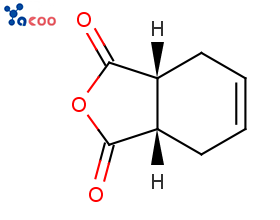2023-08-11
Product Name/English Name:cis-1,2,3,6-Tetrahydrophthalic anhydride
English abbreviation:THPA
CAS:935-79-5
Molecular Formula: C8H8O3
Article No.:S1112
Structural Formula:

Product Introduction
THPA is an important chemical product, mainly used as a curing agent for epoxy resins, a modifier for unsaturated polyester resins and alkyd resins, and an important intermediate in the synthesis of pesticides and pharmaceuticals. In addition, THPA can also be applied to nanocellulose materials.
Application of THPA
Nanocellulose (CNF) is a cellulose material with nanoscale properties, which has advantages such as high mechanical strength, high reactivity, renewability, and biodegradability. Therefore, it has broad application prospects. CNF with high charge has great potential in the application of gel, thickener, reinforcing filler, etc. due to its high solution stability and easy formation of cross-linking system due to the sufficient repulsion between nanofibers. In existing technologies, the preparation of CNF involves introducing charged groups on the surface of cellulose through a pre-treatment process, by the use of mechanical stripping for CNF filamentization. Therefore, CN115819630A patent has developed a method for preparing high charge nano cellulose, and the specific preparation method is as follows:
1. Disperse biomass raw materials in binary anhydride and 0-5% water, conduct esterification pretreatment reaction at a temperature below 120℃ to obtain the pre-treatment reaction product, wash off excess binary anhydride with water, and adjust the pH of the pre-treatment reaction product to neutral to obtain a neutral pre-treatment reaction product;
2. Disperse the neutral pre-treatment reaction products in water and use microfiber equipment to dissociate them to obtain nanocellulose;
3. Dehydrate the washing wastewater generated in step 1 to recover the binary anhydride, and use the steam generated from the dehydration treatment for reactor heating and/or condense the steam to obtain water for washing.
The binary anhydride can be Succinic anhydride, glutaric anhydride, cis-4-nenenebb cyclohexene 1,2-dicarboxylic anhydride (CAS: 935-79-5), cyclohexane-1,2-dicarboxylic anhydride, tetrahydro Phthalic anhydride and citric anhydride.
By controlling the pre-treatment temperature below 120℃, the reaction is gentler, the requirements for reaction equipment are lower, energy consumption is lower, the degree of fiber degradation is lower, and the yield of raw materials is higher; By esterification reaction with binary anhydride, carboxyl groups are grafted onto the surface of fibers, increasing the repulsive force between fibers and promoting the dispersion of basic fibers in aqueous solution. Therefore, microfibrilization can be achieved at low energy consumption, resulting in smaller and more uniform diameter, longer length, and higher charge capacity of nanocellulose.
References
CN115819630A A Method for Preparing High Charged Nanocellulose.
Copyright © Suzhou Yacoo Science Co., Ltd. All Rights Reserved
Friendly Links :
online service